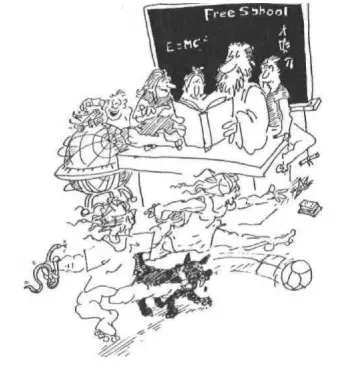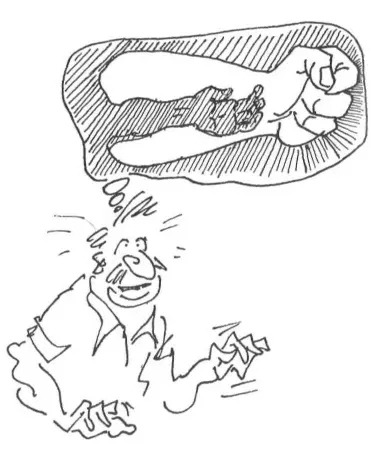Richard Bandler - Using Your Brain —for a CHANGE
- Название:Using Your Brain —for a CHANGE
- Автор:
- Жанр:
- Издательство:Real People Press
- Год:1985
- Город:Moab, Utah
- ISBN:0–911226–26–5
- Рейтинг:
- Избранное:Добавить в избранное
-
Отзывы:
-
Ваша оценка:
Richard Bandler - Using Your Brain —for a CHANGE краткое содержание
Bandler is an innovator and an original thinker in the field of psychology. This book is a transcript of Bandler live in front of an audience, cutting up and cracking jokes as he is prone to do, talking about some of his unique and often practical views on how you can change your feelings, thoughts and behavior. Change is often easier than you think if you use the right method.
Using Your Brain —for a CHANGE - читать онлайн бесплатно полную версию (весь текст целиком)
Интервал:
Закладка:
Now that seems pretty simple, and it is. Yet there is an enormous amount of claptrap written about reading problems, and a huge amount of effort goes into trying to solve reading problems. In contrast, there is an NLP–trained group in Denver (see Appendix V) that works with all kinds of educational problems. They will guarantee to raise a kid's reading level, as measured by standard tests, by a minimum of one grade level in a set of eight one–hour sessions. Usually they can make much more progress in a shorter time. In the last three years they have only had to pay off on their guarantee once. Their only prerequisite is that the kid has muscular stability in using his eyes, so he can see what he's trying to read.
Drugs
One of the other things I wanted to go after in the school system is the widespread practice of prescribing drugs like Ritalin for "hyperactive" kids who have trouble sitting quietly in rows for long periods of time, Ritalin slows them down so the teacher can keep up with them. Giving these kids drugs is always defended by saying that the drugs are harmless. One of the interesting things about Ritalin is that although it slows down hyperactive kids, its effect on adults is more like an amphetamine: it speeds them up.
So when I talked to this school district I said, "This Ritalin that you're giving the kids slows them down, but it speeds up adults, right? And you're all convinced that it's perfectly safe, and has no harmful side effects, right? Good. I have a proposal that will save you a lot of money. Stop giving it to the kids, and give it to the teachers, so that they can speed up and keep up with the kids." They were boxed in with their own logic, but they still didn't like it. Try suggesting that at your school and find out how many of those "learning disabled teachers" are willing to take a "perfectly harmless drug." The same thing happens with psychiatrists; they almost never prescribe psychoactive drugs for other psychiatrists when they're hospitalized! After thirty years of prescribing phenothiazine drugs, now they've found it causes something called "Tardive Dyskinesia" later in life. It affects your muscles so you shake all over and have trouble walking or picking up a teacup.
Woman: I'm a teacher, and just last week I was in a staff conference with a diagnostician, a nurse, and another teacher. The nurse said, "I think we should prescribe drugs for this kid," and the others nodded their heads. I got really angry, and said, "I can't believe that with all the focus on drug abuse you're recommending that this kid take drugs! How would you like to take drugs?" The diagnostician said, "I take drugs every night to calm down." And the other teacher said, "So do I." And the nurse said, "I take Valium every day." I couldn't believe it, and I was so shocked I didn't know what to say.
Well, taking drugs yourself is a lot different than forcing them on someone else. I think people should choose their own drugs. What's really sad is that most of the problems people are prescribing drugs for can be changed so easily using NLP. Any NLP practitioner should be able to fix a school phobia in half an hour, and most bad spellers can be made into good spellers in an hour or two.
However, you have to be a little careful now. NLP is starting to get well known, and a lot of unqualified people are claiming to have NLP training. There are even a few people claiming to be "the foremost NLP trainer" who have only gone through one training! That's the kind of thing that happens whenever something effective starts to get known, so be a little cautious and ask a few questions of anybody who claims to be trained in NLP.
Some good NLP people are going back into special education classes and wantonly wiping out all kinds of learning problems right and left. When you know how to find out how someone's brain works, it's relatively easy to teach him how to use it in a way that's more effective and efficient.
The capacity for learning is really actualized not when somebody inundates you with the content, but when someone can teach you the mechanism by which it can be done: the subjective structures and sequences that are necessary for learning.

IX. The Swish

The next submodality pattern I want to teach you can be used for almost anything. It's a very generative pattern that programs your brain to go in a new direction. In order to make the pattern easy for you to learn, I'm going to start with something really simple and easy. A lot of people are interested in something called "habit control." Who in here bites his nails and would like not to? (Jack steps up to the platform.) I'm going to use this pattern to get Jack to do something else instead of bite his nails.
What do you see just before you bite your nails?
Jack: I don't know. I don't usually realize I'm doing it until I've done it for a while.
That's true of most habits. You're on "automatic pilot," and later on, when it's too late to do anything about it, you notice it and feel bad. Do you know when or where you typically bite your nails?
Jack: It's usually when I'm reading a book or watching a movie.
OK. I want you to imagine that you're watching a movie, and actually bring one of your hands up as if you were going to bite your nails. I want you to notice what you see as your hand comes up, knowing that you're about to bite your nails.
Jack: OK. I can see what my hand looks like as it comes up.
Good. We'll use that picture in a few minutes, but just set it aside for now. We need to get another picture first. Jack, if you no longer bit your nails, how would you see yourself as being different? I don't mean just that you would see yourself with longer fingernails. What would be the value of changing this habit? What difference would it make to you as a person? What would it mean about you? I don't want you to tell me the answers; I want you to answer by creating a picture of the you that you would be if you no longer had this habit.
Jack: OK. I've got it.
Now I want you to get that first picture of your hand coming up, and make it big and bright, . . . and in the lower right corner of that picture put a small, dark image of how you would see yourself differently if you no longer had this habit. . . .
Now I want you to do what I call "the swish." I want you to make the small dark image quickly get bigger and brighter until it covers the old picture of your hand, which will simultaneously get dim and shrink. I want you to do this really fast, in less than a second. As soon as you've "swished" these images, either blank the screen completely, or open your eyes and look around. Then go back inside and do it again, starting with that big bright picture of your hand coming up, and the small dark image of yourself in the corner. Do it a total of five times. Be sure to blank the screen or open your eyes at the end each time you do it. ...
Now it's time to test. Jack, make that big bright image of your hand coming up and tell me what happens. . . .
Jack: Well, it's hard to hold it there. It fades out, and that other picture comes in.
The swish pattern directionalizes the brain. Human beings have a tendency to avoid unpleasantness and move towards pleasantness. First there is a big bright image of the cue for the behavior that he doesn't like. As that picture fades and shrinks, the unpleasantness diminishes. As the pleasant image gets bigger and brighter, it draws him toward it. It literally sets up a direction for his mind to go: "from here, go there." When you directionalize your mind, your behavior has a very strong tendency to go in the same direction.
Jack, I want you to do something else. Bring your hand up to your mouth the way you did when you bit your nails, (Jack brings his hand up. Just before it reaches his mouth, it stops and then lowers about half an inch.) Well, what happened?
Jack: I don't know. My hand came up, but then it stopped. I wanted to put my hand down, but I deliberately held it up there, because you asked me to.
This is a behaviorial test. The behavior that used to lead to nail–biting now leads somewhere else. It's just as automatic as what he did before, but it takes him somewhere he likes better.
This will translate out into experience. As that hand comes up and that compulsion begins in you, the feeling itself will literally pull you in the other direction. It will become a new compulsion. It's not really that you get uncompulsed, it's that you get compulsed to be more of who you want to be.
I did this pattern with a chocolate freak who kept saying she wanted to be "free." She didn't want to be compulsed because it didn't fit with the way she saw herself. After she was done, she couldn't hold a picture of chocolates. It just went "poof." Now when she looks at real chocolate, she doesn't have the old response. The direction of her thoughts is toward being attracted to what she wants to be. It's a new compulsion. You could call this pattern "trade compulsions." I said to her, "Now you're really stuck. You're compulsed to not be able to make these pictures," and she said, "I don't care." She doesn't really object to being compulsed; she just wants to be compulsed in her own way. That's really the difference that makes a difference.
The swish pattern has a more powerful effect than any other technique I've used. In a recent seminar there was a woman in the front row moaning and groaning about having tried to quit smoking for eleven years. I changed her in less than eleven minutes. I even chose what to put in the little dark corner picture; I'm not what people call a "non–directive clinician. 1I told her to see an image of herself politely enjoying other people smoking. I wasn't willing to create another evangelist convert. I didn't want her to see herself sneering at smokers and making life miserable for them.
Now I want you all to pair up and try this pattern. First I'll go through the instructions again.
The Swish Pattern
1. Identify context. "First identify where you are broken or stuck. Where or when would you like to behave or respond differently than you do now? You could pick something like nail–biting, or you might pick something like getting angry at your husband."
2. Identify cue picture. 'Now I want you to identify what you actually see in that situation just before you start doing the behavior you don't like. Since many people are on 'automatic pilot' at that time, it may help to actually do whatever has to precede the behavior, so you can see what that looks like." This is what I did with Jack. I had him move his hand toward his face and use that image. Since this is the cue for some response that the person doesn't like, there should be at least some unpleasantness associated with this picture. The more unpleasant this is, the better it will work.
3. Create outcome picture. "Now create a second image of how you would see yourself differently if you had already accomplished the desired change. I want you to keep adjusting this image until you have one that is really attractive to you — one that draws you strongly." As your partner makes this image, I want you to notice her response, to be sure it's something that she really likes and really attracts her. I want her to have a glow on her face that tells you that what she's picturing is really worth going for. If you can't see evidence that it's worth going after as you watch her, don't give it to her.
Читать дальшеИнтервал:
Закладка:








